Digital arts practices have implications for education effecting the form and modality of work by staff and students and posing challenges for contemporary curriculum in the creative arts. This post will introduce three issues that are of particular importance to digital arts education; interdisciplinarity, collaboration, and learning context.
Interdisciplinarity is native to the digital arts. It arises from the interoperability of digital data between modes of output—as sound, graphics, 3D printing, robotics and text. This has implications across the arts and with the sciences. Education institutions are often built on well-established and highly specialized silos of expertise, with clear boundaries and goals. This rigidity can be a barrier for digital arts educators whose challenge is to maintain the foundations of disciplinary traditions whilst influencing and expanding the field.
Creative collaborations are becoming more frequent as a result of digital data exchange and internet-based communications. Managing these collaborations in creative fields where the individual artist has long been esteemed provides a tension to be managed. Creativity also occurs in partnerships with the computer that range from the use of the machine as a tool to machines acting as autonomous creative systems. Along with the challenges of human-computer interaction comes a societal fear that the embracing of computers raises suspicion about the authenticity of creativity within digital arts.
The pedagogical and cultural contexts in which digital arts learning takes place are being effected by mobile devices and online interactions. These provide students with the ability to experience and create artworks in many environments and conditions. Locative technologies (GPS, augmented reality, mobile phones, etc.) have brought digital practices into studios, taken them outdoors and put them onto the stage. The impact of this on the development of student creativity and pedagogical practices is still unfolding. As well, the consumption of creative work is being altered by these mobility trends. Traditional disseminators of artworks, such as galleries or funding bodies are less potent in acting as cultural gatekeepers.
This is an outline of the keynote presentation by Andrew R. Brown at the Adobe Education Leadership Forum, held in Malaysia in April 2014.

